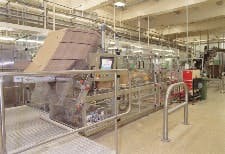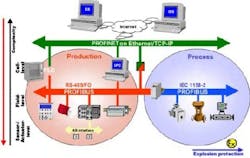By Wayne Labs, Contributing Editor
If youve been successful with your particular brand of fieldbus, youll be hesitant to change as long as it continues to meet your performance requirements and is compatible with the drivers, servers, applications, network infrastructure and hardware you already own. But if your process needs improved performanceor real-time functionality, perhaps you should consider a higher-speed version of the fieldbus you already use.
On the other hand, if youre starting from scratch, you can pick architectures that let you scale up when the need arises. In this case, you have a choice of the old fieldbus stand-bys with their TCP/IP upgrades or a totally Ethernet-based system. Either choice gets you off the old serial cable and onto Ethernet, the ubiquitous networking wiring standard.
A word of warning, though. Just because you choose a standards-based Ethernet at Layers 1 (physical) and 2 (data link) with TCP/IP at Layers 3 and 4 of the ISOs OSI Table (See OSI Table), youre not guaranteed that your systemson the same Ethernetcan talk to each other. Sometimes, however, this lack of communication may be exactly what you want because Ethernet can transmit as many application protocols as you need.
Know Your Requirements
While an industrial network might respond in real time to changes in process variables, a real-time response doesnt necessarily guarantee a deterministic response within a predefined period every time conditions trigger it. In many cases, having a deterministic cycle will be more important than a real-time response.
"Because the life cycles of most plant extend beyond a 15-year period, it's important to pick a network that will withstand the test of time." |
For example, real time for a temperature-monitoring circuit may be an update (or cycle time) every 5 to 10 seconds. But real time for motion control may be less than a millisecondoften microseconds. Yet, if a process goes over temperature and causes an excessive pressure condition, you cant afford to have your network entertain idle chatter from all its nodeswhich is often the case with a non-deterministic network such as an office Ethernet. Rather, youll need to guarantee that your over-temperature message gets through, and this is where determinism is an important factor in your choice of industrial networks.
Ways to Control Network Traffic
Network nodes need a traffic cop to guarantee that everyone doesnt talk at once, thus restricting the timely flow of data.
Two methods of controlling traffic are a token-passing arbitration scheme that tells nodes when they can talk, and a master-slave communication system that describes how and to whom they can talk. These OSI Layer 2-based traffic rules or protocols help to guarantee determinism. This is not to say that other arbitration and communication schemes wont provide determinism and real-time communications but, when it comes to determinism and real-time performance, its necessary to consider Layer-2 protocols and overall network speed. In general, faster network speeds bring faster response times. Another rule of thumb: If you need really fast cycle times, keep networks small and use more than one.
According to Bob Bettendorf, former controls engineer and now technical documentation manager for machine builder and automation supplier Mesto Automation, the fundamental reason for separating networks into certain applications is the amount of data that needs to be dealt with in each time interval. For example, he says, Ethernet has quite a bit of overhead in a data packet with a large packet size, so to use it to transmit the 1s and 0s from a proximity switch would result in inefficient use of the network bandwidth. He recommends a network with less overhead and a smaller packet size for that application while the reverse would be true when large chunks of data need to be transmitted.
Pass a Token for Predictable Response
One of the early token-passing networks (IEEE 802.4) was ArcNet, which still is used today. Another token-passing system, MAP (General Motors Manufacturing Automation Protocol) died an early death due to lack of product support and $3,000 network nodes. ControlNet is another example of a token-passing network (Concurrent Time Domain Multiple Access, or CTDMA)) that has a total overhead of seven bytes, network update of 2 ms, and frame sizes up to 510 bytes. Profibus-DP/PA is yet another popular token-passing system with update times under 2 ms, depending upon configuration.
Token-passing schemes, which logically place nodes in a circular path, allow each node to receive data from one neighbor and pass itand any of its own dataalong to its other neighbor in a round-robin fashion. The more nodes on the network, the longer the travel time for data to make the trip around the complete circle.
With limits on packet sizes, its easy to determine how long it takes data from a sensor to reach a control node, and that timing will always be the same unless nodes are added or subtracted. For this reason, token-passing architectures have been very popular in manufacturing.
ArcNet uses peer-to-peer communications and can handle node addresses from 0â255 on a single network; address 0 is reserved for broadcast messages. ArcNet packet lengths can range 0-507 bytes, and have little overhead (the data link protocol is contained in the ArcNet controller chip)and when combined with a data rate of 2.5-10 Mbps, responses to short messages are quick. CRC-16 (cyclic redundancy check) provides robust error checking for industrial applications. The network reconfigures itself when nodes are added or deleted, and active and passive hubs extend its range.
In combination with a real-time operating system (RTOS) such as QNX, ArcNet provided the backbone for postal sorting machines used across the U.S.
"A real-time response doesn't necessarily guarantee a deterministic response within a predefined period every time conditions trigger it, in many cases, having a deterministic cycle will be more important than a real-time response." |
When a Lockheed Martin business unit, Distribution Technologies in Oswego, N.Y., needed to replace an existing serial port control network, ArcNet was the network of choice. The 150-ft.-long machines have three key functions: induction, transport, and delivery. Each induction station and the 8th, 12th, and 16th delivery bins are controlled by 16 computers distributed throughout the machine. One PC/104 ArcNet card resides in the boot server, and one card resides in each of the diskless computers. Capable of sorting 11,000 packages per hour, the machines use ArcNet adapter cards with QNX drivers from Contemporary Control Systems (www.ccontrols.com). Automatic bar code readers determine where parcels ultimately go.
From Process to Motion Control
According to ARC Advisory Group (www.arcweb.com), there were more than 10 million Profibus nodes installed worldwide by the end of 2003. Approximately 1.6 million nodes are used in process automation, more than 300,000 of them for connection to field instruments based on the Profibus-PA spec. Typically a master-slave communication system, Profibus provides four different transmission technologies, all based on international standards. RS485 and RS485-IS (an intrinsically-safe version) are simple to implement, cost-effective and primarily used for high transmission rates. Various rates can be selected between 9.6 Kbps and 12 Mbps, and up to 32 stations (masters or slaves) can be connected in a single segment. MBP (Manchester coding and Bus Powered), now commonly used in the petrochemical industries, replaces the earlier IS version and is defined with a synchronous transmission rate of 31.25 Kbps. Fiberoptic transmission can be used in areas of high noise or where IS operation is important.
Profibus-DP (decentralized peripherals), geared toward discrete applications, supports both single-master and multi-master systems. A maximum of 126 devices (masters or slaves) can connect to a single bus. Typically, in a single-master system, a DPM1-class PLC or PC will be the master and communicate with each of the slaves at a specified message cycle.
In a multiple-master system, additional devices can be connected for engineering, configuration, or operation, and are called DPM2-class devices. DPM2 devices do not have to remain connected, but do have active bus access. Slaves include I/O devices, drives, HMIs, valves, transducers, etc. DPM1 masters can multicast to slaves, and slave-to-slave communication in publish-subscribe mode can be used to cut response times on the bus by up to 90%. Profiles describe the parameters and behavior of devices and systems that belong to a profile family, for example PA for process devices. Profiles take into account the application and type-specific features of field devices and controls, and make interchangeability of manufacturers components easier.
Where Speed Counts
A place where speed counts is the packaging side of hybrid operations. Profibus lends itself pretty well to these applications, where batch and packaging operations make up the entire processsuch as at Miller Brewing Co.s breweries worldwide or Mercks pigment production plant in Germany.
Higher line speeds and the ability to optimize machine efficiency by maintaining ratios between the drives through to full line speeds is achieved via the high speed communications of Profibus.
One packaging machine company using Profibus is Roberts PolyPro, which manufactures a french fry carton maker that runs at 1,800 ft./min., producing 260,000 scoops/hr. (See Figure 1). According to chief engineer, John Young, a Profibus-based system allows the use of standard motors and vector drives for an off-the-shelf solution that, he says, improves machine performance, decreases maintenance, and eliminates costly and troublesome wiring. Machine setup was significantly improved using recipe capabilities passed over the bus.
Modbus Goes Public
Modbus started out as a peer-to-peer serial network in the 1960s, and many years ago its proprietary protocols ran on Ethernet and MAP networks. Ownership recently was transferred from Schneider Electric to Modbus-IDA, an independent, nonprofit organization. It has also been accepted by the IEC as a publicly available specification (PAS) currently known as IEC PAS 62030. The TCP variant of the protocol, along with a companion protocol known as real-time publish/subscribe (RTPS), was submitted to IEC SC65C as a real-time industrial Ethernet suite.
According to Modbus-IDA president, Ken Crater, reformatting of the spec to allow for better integration into the revision of IEC-61158 will be a major push in its promotion.
Modbus protocols run on serial networks and higher-level LANs. Like Profibus, Modbus also runs as a master-slave network. The master initiates transactions called queries and sends out broadcast messages. Typical master devices include host processors and programming panels, and slaves include PLCs. At the message level, Modbus applies the master-slave principle while the network communication method is peer-to-peer. If a controller originates a message, it does so as a master and expects a response from a slave. Modbus protocols use special function codes to define specific operations.
Foundation Fieldbus
According to Ian Verhappen, consultant at ICE-Pros Inc. and regular columnist for Industrial Networking, Foundation fieldbus (FF) is gradually finding application in discrete manufacturing. He finds this is especially true with the faster, Ethernet-based HSE networking, but it still is predominantly a process-oriented bus. Verhappen says many new plants in Europe are going with FF, and its not uncommon to see a new plant there with 15,000 points. Foundation fieldbus H1 format has a typical cycle time of 100-600 ms depending on type and number of nodes, and its HSE has a latency of less than 5 ms.
Actually, FFs greatest benefit to users may not be performance as defined by cycle times or latency, but in its smart instrumentation.
For Shell Oil, a leading adopter of FF technology in its reinstrumentation projects, a 1% improvement in plant asset utilization enabled by fieldbus technology generates a $2 million savings per year. Another 1% reduction in fixed operating costs saves Shell some $1 million per year.
CAN Performs In Factory Automation
CAN was designed for real-time control. It has small data frames less than eight bytes in length; larger packets, however, can be used for setup, configuration, and diagnostics. CAN defines only the datalink layer and a small part of the physical layer in the OSI 7-layer model.
This spawned several higher-layer protocol-based networks that use the underlying CAN layers. Examples include CANopen, DeviceNet, SDS, J1939, etc. CANs data link layer permits collisions but also resolves the collision so that a meaningful message is still transmitted. It uses a protocol termed Carrier Sense Multiple Access with Non-Destructive Bitwise Arbitration that guarantees that the highest priority message will get through.
CAN is well-suited to real-time applications such as motion control because it provides developers with standardized communications objects for real-time data (Process Data Objects, or PDOs), configuration data (Service Data Objects, or SDOs), and special functions (Time Stamp, Sync message, and Emergency message) as well as network management data (boot-up message, NMT message, and Error Control). Device profiles define process data, configuration parameter and diagnosis information. Part of the process data is the Control Word and the Status Word. The Control Word is used for controlling, for example, a drive-specific Status Machine. The drive transmits the current status back to the application, keeping the controller up to date.
The CANopen profile for drives describes servo controllers as well as stepper motors and frequency inverters. The device profile defines a number of modes, for example, positioning mode, interpolating positioning mode, profile speed mode, profile torque mode, speed mode and homing mode. CANopen has a cycle time for 256 discrete signals16 nodes of 16 I/O each, for exampleof less than 1.0 ms.
The System 2100 case/tray packer from Kappa Corrugated uses CAN bus to achieve fast scan cycles for servo control.
A good example of CANs use in motion control applications is a packaging machine control system developed by Baldor for Kappa Corrugated UKs packaging systems division (See Figure 2). The System 2100 case/tray packer uses an intelligent drive, and incorporates a machine control system running the Basic-like Mint motion language. The system includes I/O for the associated sensing and actuation tasks and a CAN bus, which is used to interface with an HMI.
Towards Ethernet-Based Systems
While Microsoft and Apple have given their respective NetBEUI and AppleTalk protocols a ride on TCP/IP-based Ethernets, industrial fieldbus vendors have been doing the same. The many benefits of Ethernet TCP/IP networks, however, dont necessarily work to the advantage of the industrial needs of real time and determinism. Thus, in each case many work-arounds have been created to make Ethernet TCP/IP a reasonable industrial-strength communications medium.
Ethernet (IEEE 802.3), which started out as a network designed to avoid collision among nodes transmitting messages (hence its descriptive Carrier Sense Multiple Access/Collision Detect CSMA/CD) moniker) is not exactly what would be called deterministic. Its half-duplex transmission system meant each node listened before transmitting, but if two nodes transmitted at the same time, they had no way of knowing they interfered with one another. TCP became the tool used to guarantee connection between sending and receiving nodes. Today, full-duplex controllers and intelligent switches make up for many of these shortcomings, allowing nodes communicating with one another to have a private line while connected.
Ethernet speeds have increased from 10 Mbps to 100 Mbps, and equipment capable of Gigabit-level speeds is becoming available. Speed increases of this magnitude can make up for any of Ethernets inherent lack of determinism. Commercial off-the-shelf (COTS) networking products make it attractive to put industrial fieldbuses on Ethernet, and the ability to integrate plant-wide data more easily with enterprise applications adds to its effectiveness. Migrations to Ethernet are common. See the sidebar for more information on Ethernets flavors.
A Word to the Wise
Its vital to consider the permanence of a network solution. For example, ArcNet and Ethernet technologies have been around since 1976. Verhappen notes that because the life cycles of most plants extend beyond a 15-year period, its important to pick a network that will withstand the test of time. A good tabular comparison can be found at Grid Connects (formerly Synergetic) web site at www.synergetic.com/compare.htm.
This article merely scratches the surface on industrial networks for real-time control. Watch for a feature article on the emerging flavors of industrial Ethernet this summer in the pages of Industrial Networking.

Leaders relevant to this article:






